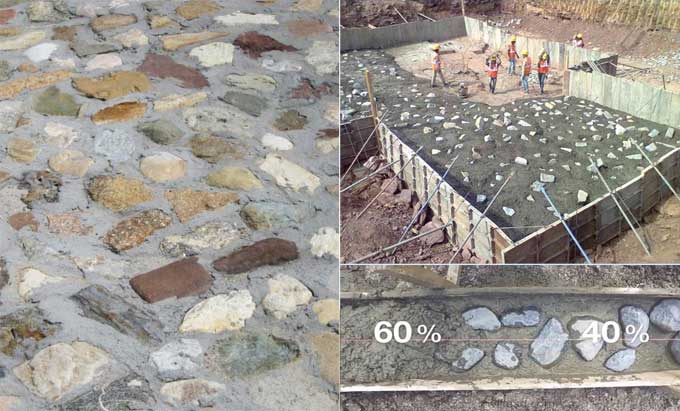
Everything you need to know about Plum Concrete
Water, sand, cement, and aggregate are combined to create concrete, which hardens into a mass resembling stone. In English, concrete, from the Latin word concretus, means "to grow together." Concrete is made of large aggregate particles glued together by a firm matrix of material that fills the spaces between the aggregate particles.
Concrete is given names like Plum concrete, Rice husk concrete, Fly ash Concrete, etc. depending on the type of filler and binder employed. Let's talk about what plum concrete is in this post and how plum is utilized as a filler in plum concrete.
The word "Plum" describes the firm, pristine natural stones used in mass concrete works such as foundations, gravity dams, embankments, and other mass concrete works. Plum concrete is created by adding medium to big stones as fillers that range in size from 300mm and higher.
In order to prevent using too much cement without sacrificing strength, it is used to enhance the apparent yield of concrete for a given amount of cement.
Plums are the term for the huge stones utilized. These plums go into the production of mass-produced concrete. The volume of plums, however, shouldn't be more than 30% to 40% of the overall volume of the completed concrete. Rubble concrete or Cyclopean concrete are other names for plum concrete.
Rubble concrete or Cyclopean concrete are other names for plum concrete. The Plum shouldn't be any bigger than the cross-section of the concrete mixer or one-third of it.
The components should be wet before mixing, and the plain concrete utilized for this task must have minimal resistance. The ASTM standard should be followed while selecting stone materials, and specifications will follow the concrete design.
How to manufacture the Plum Concrete?
Plum concrete, often referred to as rubble concrete or Cyclopean Concrete can be produced in two straightforward ways.
To create it, either distribute the plums over the layer of regular concrete before adding another layer of concrete or add the plums to the concrete mix as it is being mixed. To avoid air traps, more care must be taken when setting the plums in the concrete.
The following is the general production process:-
Quality of the Aggregates
Ideally, the stone that will be used as plum material will come from a type of rock that is similar to the kind that is used in the aggregates, so that it will be robust and long-lasting.
There should not be any flaky texture to the surface and there should not be any dirt or clay present. Any dust that may be present on the surface of the plum material should be cleaned before its use.
Segregation of the Aggregates
To begin with, the stones needed for the production of plum concrete are meticulously hand-picked. As a result, the plum material has been batch-processed. The plum material shall have a maximum thickness.
The plum material's volume should not exceed around one-third of the overall volume of concrete. The plum material may be hand-picked or just chosen at random by the staff members and transported to the location.
Placement of the Aggregates
The plum substance is applied to the surface at a predetermined interval. The amount of concrete needed will reduce by up to 50% and the amount of plum will rise by up to 50% if the plum materials are positioned closely together.
A layer of concrete is then poured over the plum material. Another layer of plum material is placed on top of the concrete once the spaces between the plum materials have been gradually filled with concrete. Until the required level is attained, this process is repeated.
Avoiding air traps while pouring plum concrete requires extra care because doing so might reduce the concrete's strength. Additionally, one must make sure they are situated.
Application Plum Concrete
This type of concrete is mainly used to level the ground below the foundation, where the surface is uneven. Additionally, it is also used to level the surfaces in places of sloping ground. The use of plum concrete in the foundation enables minimization of the cost.
In the case of sloping ground, the plum concrete provides additional stability to the structure. It is also used for machine foundations where mass concreting is needed only to increase the mass of the foundation.
Constructing Dams and Bridges
Plum concrete is more frequently needed while building large constructions like gravity dams and bridges. However, the maximum permitted size of plum material used to build dams and bridges is 150mm.
Used in Constructing Roads
It is widely employed in machine foundations when a substantial mass is required for the machine's and the foundation's safety. It offers a cost-effective option there.
To get more details, watch the following video tutorial.
Video Source: Anime_Edu - Civil Engineering Videos
Wrapping it up
One of the most adaptable and frequently manufactured building materials worldwide is concrete. Concrete will remain the most extensively utilized material due to its unique benefit.
The need for infrastructure development is growing daily as a result of rising population, living standards, and economic growth, which also raises the volume of concrete needed for mass concreting.


